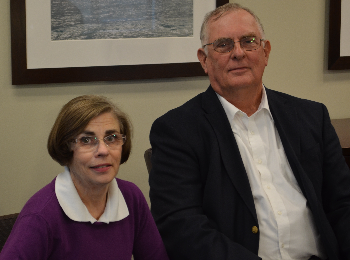By India Ogazi

Mary-Wallace and George Montgomery.
After waiting three weeks for the biopsy results, Montgomery found out that his oncologist had been unable to get to the suspicious tissue, but instead had gathered healthy tissue. The biopsy was a failure. Montgomery still didn’t know if he had lung cancer.
His fear turned to hope, however, when he ran into old family friend Dr. Maurice Willis, director of the hematology/oncology clinic at the University of Texas Medical Branch at Galveston. Willis was visiting his hometown of Waverly Hall, Ga. when Montgomery shared his medical dilemma with him.
Willis calmed Montgomery’s fears as he explained that UTMB had advanced imaging technologies that could pinpoint a hard-to-reach mass like his. If it turned out to be malignant, UTMB could remove the affected areas of the lung using minimally invasive surgical techniques.
“Minimally invasive surgery offers patients less scaring, less pain, a faster recovery and minimal blood loss,” said Dr. Daniel Beckles, associate professor of cardiothoracic surgery and medical director of minimally invasive cardiac and thoracic surgery at UTMB.
Minimal blood loss was an important factor for Montgomery because he is a Jehovah’s Witness and doesn’t accept blood transfusions.
So Montgomery drove from Georgia to Texas with new-found hope.
Within five days he had a biopsy, received a diagnosis, underwent surgery and was released from the hospital.
The UTMB radiologist used the CT scan to guide his biopsy needle, which he inserted under Montgomery’s right arm and reached the mass on the lung’s inner wall. They examined the biopsied tissue immediately in the exam room.
The mass was in fact a golf-ball-sized, cancerous tumor.
A video-assisted minimally invasive lobectomy was the best treatment plan. During surgery a series of small incisions were made into the chest to allow for the insertion of a video camera and small instruments to remove tissue.
Beckles is a board certified thoracic surgeon and one of only a few doctors in the nation able to perform this kind of minimally invasive lung surgery.
According to the Society of Thoracic Surgeons, only 15 to 30 percent of thoracic surgeries are performed with the minimally invasive technique. In traditional “open” lobectomies, a longer incision is made on the chest and the ribs may have to be spread, leading to a much more painful and lengthy recovery.
“The fact that we were able to remove two of the three lobes from his right lung and he was well enough to ride back to Georgia just one day after surgery shows the speed in recovery from our minimally invasive technique,” said Beckles.
Montgomery said he was amazed at how quickly everything happened at UTMB. “It took my doctor in Georgia three weeks just to give me my biopsy results. I’ll never go anywhere else.”